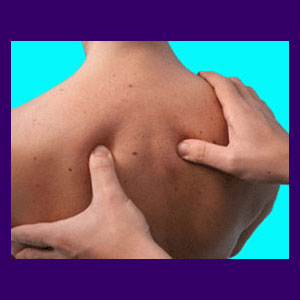
Thoracic back pain describes discomfort and related symptoms in the middle back region. Patients with thoracic pain often complain of tightness and pain between the shoulder blades which can definitely impede on the physical functionality of the upper body. Middle back pain often spreads into the neck or shoulder region, since the muscles of the middle back work so closely with these other anatomical areas. Statistically, thoracic symptoms are the least common of any spinal region. However, when they are present, they can be very disabling.
This dialog investigates the occurrence of various types of pain in the upper and middle spinal regions.
Thoracic Back Pain Conditions
The majority of mid back complaints are due to muscular injury. The middle back muscles are used for so many different tasks and are frequent victims of overuse. Back muscle pain is generally not serious, but may be very uncomfortable for a short time frame.
The middle back region is not prone to degenerative back pain nearly as much as the lumbar and cervical regions. The middle back is made for structure and support, not flexibility. Therefore, this area does not suffer the same anatomical deterioration as the other more mobile areas of the spine. Regardless, it is still possible to experience herniated discs, degenerative disc disease, arthritis and facet joint syndrome in the thoracic spine. Just remember that mild cases of these conditions are rarely symptomatic and are usually not responsible for long-term chronic back pain syndromes.
Thoracic outlet syndrome can be a specific non-spinal cause of persistent upper back, shoulder and arm symptoms.
Thoracic Back Pain Facts
Middle back pain is the least common dorsopathy complaint. Chronic pain conditions are rarely exclusive to the mid back area.
Many patients with a primary pain zone located in a more problematic spinal region suffer secondary pain in the middle back region. This secondary pain often comes and goes as the primary pain intensifies or lessens. Patients with this particular condition are sometimes suffering from a psychosomatic back pain syndrome which enacts regional symptoms due to ischemia, rather than location specific symptoms based on a single spinal abnormality. This can be true regardless of whether a structural abnormality exists in the thoracic section or whether no irregularities can be implicated as the possible source of pain.
Thoracic Pain Experiences
Thoracic symptomology is a type of pain I never experienced regularly until just recently. I did occasionally hurt some muscles in between the shoulders, either in martial arts training or doing chin-ups. My pain was (and still is) typically based in the lumbar spine and has since also moved to the neck. I began to suffer upper and mid back issues after a tripping incident in early 2011 and the condition has become a recurrent problem for me ever since.
Some patients have a similar pain profile, with primary pain zones in the lower back or neck. This additional middle back pain is often blamed on the primary problematic region influencing the mid spine and causing symptoms. This is rather common, especially compared to patients who only have mid back issues and no neck or low back symptoms at all.
In my own experience, I find many mid back pain conditions to be ischemic or muscular, but not spinally-motivated, except in cases of obvious serious defects in the thoracic region, usually caused by concentrated trauma, such as a car accident or significant fall.




